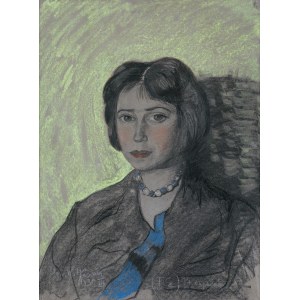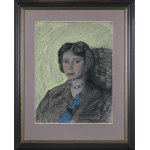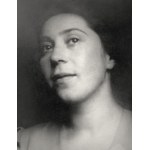pastel, light gray paper with filigree TIZIAN
signed l.d.: Ignacy Witkiewicz | 1930 III | (T.E) P + empedete
p.g. number (in pencil): 687
The painting has an expert opinion by Dr. Anna Zakiewicz, dated November 2022.
Type E presupposed "any psychological interpretation according to the Company's intuition," which in practice meant portraits of women of distinctive beauty and those that the artist liked. It cannot be denied that Jadwiga Truskolaska (1904-2003) was distinguished by her remarkable beauty both at the age of 26, when Witkacy made her portrait, and indeed at a later age, as evidenced by her photograph from the family collection (opposite). Jadwiga Truskolaska was a graduate of mathematics at the Jagiellonian University, and later a teacher of this subject at the high school in Jaslo, where she was from, and lived with her husband Zdzislaw (1899-1949), a painter influenced by Witkacy in his work. Like the artist, they both belonged to the social circle of Jan Leszczynski, a philosopher and professor at the Jagiellonian University, whose family estate was located in Tarnowiec near Jaslo. Several references in Witkacy's letters to his wife indicate that the artist had a great affection for Truskolaski, which probably extended to the painter's wife as well. In addition to her portrait, Witkacy made two portraits of Truskolaski (in January and May 1929), called him his "pupil" and even invited him to live together (April 5, 1929) in the Zakopane boarding house "Zośka" run by his mother, Maria Witkiewiczowa.
In addition to the type designation, annotations on Mrs. Truskolaska's portrait indicate that on the day it was taken, Witkacy smoked cigarettes (P) and also drank tea ("empedete" is a phonetic transcription of the French un peu du thé, meaning "a little tea"), which he considered a strengthening agent and often nourished himself with it before or during a portrait session.
The portrait is from the collection of Jan Leszczynski, and was deposited in the National Museum in Cracow (N.D. 5235) until 1991. It also participated in an exhibition at the MNK in 1980.
The image of Jadwiga Truskolaska is distinguished by an unusual background - outlined almost uniformly in yellow pastel, slightly enhanced around the model's head, behind which the artist placed her shadow. This alludes to Witkacy's experiments with light during his youth (before 1914), later this phenomenon is rare.
Following the expert opinion of Dr. Anna Żakiewicz
Painting exhibited, mentioned and reproduced in:
- Stanisław Ignacy Witkiewicz 1885-1939: Painting - Photography - Drawing - Portrait Company. On the fortieth anniversary of the artist's death, texts by Mieczysław Porębski et al, MN in Cracow, II 1980, cat. no. 255;
- Bumar Calendar 1985, color repr. II;
- Stanisław Ignacy Witkiewicz 1885-1939. catalog of paintings, ed. I. Jakimowicz with the collaboration of A. Żakiewicz, MN in Warsaw, 1990, item I 1205;
- S.I. Witkiewicz, Letters to his wife (1928-1931), ed. J. Degler, Warsaw 2007, pp. 53, 85, 97, 107, 111, 270, 340.
Stanisław Ignacy Witkiewicz (Warsaw 1885 - Jeziory in Volhynia 1939) was educated at home under his father, Stanisław Witkiewicz. In 1903 he passed his high school diploma in Lviv. In 1904 he began traveling, including to Vienna, Italy, Munich, Paris and London. Between 1904 and 1910 he studied at the Academy of Fine Arts in Cracow with Prof. Jozef Mehoffer, interrupted by periods of study with Władysław Ślewiński. In 1914 he left with Bronislaw Malinowski's expedition to Australia, and from there went directly to St. Petersburg, where he enlisted in the Russian army after the outbreak of WWI. In Russia, he witnessed the Bolshevik Revolution.
After returning to the country in 1918, he became a member of the "Formists" group, with which he exhibited from 1918 to 1922. In the painting of this period, he came closest to putting into practice his own theory of Pure Form, formulated during the war (it also applied to drama). Along with Leon Chwistek, he was the main theoretician of the grouping. After 1924, he operated as a one-man "S. I. Witkiewicz Portrait Company'' making custom portraits. At the same time, he continued his literary (dramas, novels) and philosophical work, but above all he practiced the "art of living" that united all forms of his activity, appreciated only at the end of the 20th century. He committed suicide at the beginning of World War II, the day after the Soviet aggression against Poland.














